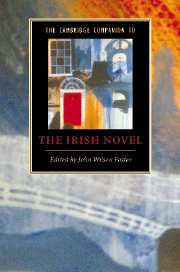Book contents
- Frontmatter
- Introduction
- 1 The novel before 1800
- 2 The national tale and allied genres, 1770s-1840s
- 3 The novel of the big house
- 4 The Gothic novel
- 5 Catholics and fiction during the Union, 1801-1922
- 6 Irish modernisms, 1880-1930
- 7 James Joyce
- 8 Region, realism and reaction, 1922-1972
- 9 The novel in Irish
- 10 Women novelists, 1930s-1960s
- 11 Two post-modern novelists: Samuel Beckett and Flann O’Brien
- 12 Life writing in the twentieth century
- 13 The novel and the Northern Troubles
- 14 Contemporary Irish fiction
- Index
9 - The novel in Irish
Published online by Cambridge University Press: 28 January 2007
- Frontmatter
- Introduction
- 1 The novel before 1800
- 2 The national tale and allied genres, 1770s-1840s
- 3 The novel of the big house
- 4 The Gothic novel
- 5 Catholics and fiction during the Union, 1801-1922
- 6 Irish modernisms, 1880-1930
- 7 James Joyce
- 8 Region, realism and reaction, 1922-1972
- 9 The novel in Irish
- 10 Women novelists, 1930s-1960s
- 11 Two post-modern novelists: Samuel Beckett and Flann O’Brien
- 12 Life writing in the twentieth century
- 13 The novel and the Northern Troubles
- 14 Contemporary Irish fiction
- Index
Summary
The Gaelic Revival
The novel came late in Irish. Despite an unbroken literary tradition that predates the arrival of literacy and Christianity, the fortunes of history decided that secular prose composition for the ordinary reader would be much attenuated. While the major world languages were developing the novel for the growing literate public in the eighteenth and nineteenth centuries, the Irish language was retreating both socially and geographically. There may have been more Irish speakers than ever before on the cusp of the Great Famine in 1845, but they were almost exclusively poor and unlettered. Had somebody written a novel in Irish at that time, its readership would have been confined to a small coterie of scholars (many of whom were learners), some members of the new Catholic middle class - a class that in large measure was trying to forget the language as quickly as it could - and whatever scribes remained, who would have looked down upon it as a poor substitution for the traditional literature. We can be sure that it never entered the head of William Carleton, a native speaker of Irish, to write in his native tongue.
- Type
- Chapter
- Information
- The Cambridge Companion to the Irish Novel , pp. 171 - 188Publisher: Cambridge University PressPrint publication year: 2006



